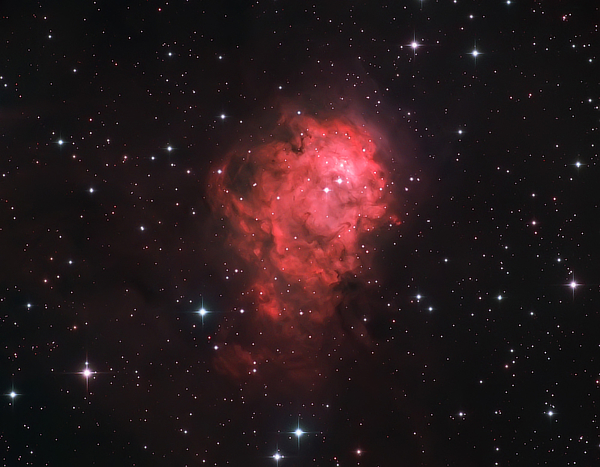NGC 7538 in Cepheus
September 2023 - Nebula and Cluster of the Month
We’ll only be looking at a single object this month. It’s a little-known gem that rides high in the September sky, being circumpolar from latitudes north of N39°.
NGC 7538 lies in the constellation of Cassiopeia, about 1.3° west of the splashy open cluster M52, and close to the border with Cepheus. It was first seen by William Herschel on the night of 3rd November 1787. He wrote Pretty bright middle. Two considerable stars involved in nebulosity, 2’ long, 1½’ broad
. He placed it in his second class of objects, ‘faint nebulae’ as no. 706.
NGC 7538 lies at a distance of a little over 9,000 light-years, in the Perseus arm of the Milky Way. It is an active star-forming HII region and has made news by harbouring what is believed to be the largest protostar yet observed.

Within the nebulosity lie three infra-red sources, labelled IRS 1, 2 and 3. Studies of 1.3mm continuum emission have revealed nine sources, labelled MM1–MM9. By far the strongest, MM1 is roughly coincident with IRS 1. Within MM1 lies a still-forming O-type giant protostar, with a mass of approximately 25 suns.1
Other condensations have been detected within the infra-red sources, leading astronomers to describe the NGC 7538 star-forming region as ‘a massive cluster in the making.’2
It is fascinating to think that in just a few million years, a new, brilliant open cluster will emerge from the formative gas and dust that is NGC 7538.
From the point of view of the visual observer, NGC 7538 is not spectacular, but it is a remarkable little object and well worth hunting down. Herschel considered it ‘faint’, and without any help from filters it is, but a good UHC filter or an OIII filter will improve your chances of seeing it enormously.

The sources do not give a magnitude for the object (nor, in fact, for any nebula). I don’t know why, but for what it’s worth, I would estimate the magnitude to be somewhere between 11 and 12.
Immediately visible are two equal-brightness (magnitude 11.6) stars, separated by 30” and orientated NNE-SSW. With the filter in place, the nebulosity should be comfortably visible. Data sources, such as the Deep-Sky Field Guide to Uranometria, give the size of the visible nebulosity as 9’ x 6’. Perhaps unsurprisingly, I saw less than this from my light-polluted site. I estimated a size of about 4’ x 3’. The nebulosity appeared elongated and oval in shape, sharing the same orientation as the two bright stars.
I found that it was clearly seen using both a UHC filter and an OIII filter. I suspect that from a site not much superior to mine, it could well be visible without any filters in place.
| Object | RA | Dec | Type | Magnitude |
|---|---|---|---|---|
| NGC 7538 | 23h 13m 31s | +61° 30’ 09” | HII star-forming region |